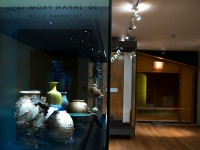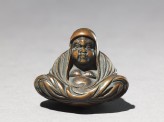Room 36 | Japan from 1850 gallery
Explore the major technical and creative developments in arts and crafts of Japan after 1850 and visit the Ashmolean's tea house.

Buddhism arrived in Japan from China and Korea around AD 550. It was adopted as an official religion in the belief that it would bring with it the sophisticated culture of continental Asia and help to unify Japan.
Buddhism quickly took root in Japan, partly because of its willingness to co-exist with the native Shinto religion (the Way of the Gods). It had a great influence on art, architecture and literature.
The type of Buddhism now dominant in Japan is Mahayana Buddhism, which teaches that enlightenment is available to all, not just to those who lead a monk's life of self-discipline and meditation.
Today most Japanese consider themselves Buddhist, Shintoist or both. Religion does not usually play a big part in everyday life, but many people visit a Buddhist temple or Shinto shrine at New Year and have Shinto wedding ceremonies and Buddhist funeral ceremonies.
Notice
Objects may have since been removed or replaced from a gallery. Click into an individual object record to confirm whether or not an object is currently on display. Our object location data is usually updated on a monthly basis, so contact the Jameel Study Centre if you are planning to visit the museum to see a particular Eastern Art object.
© 2013 University of Oxford - Ashmolean Museum






